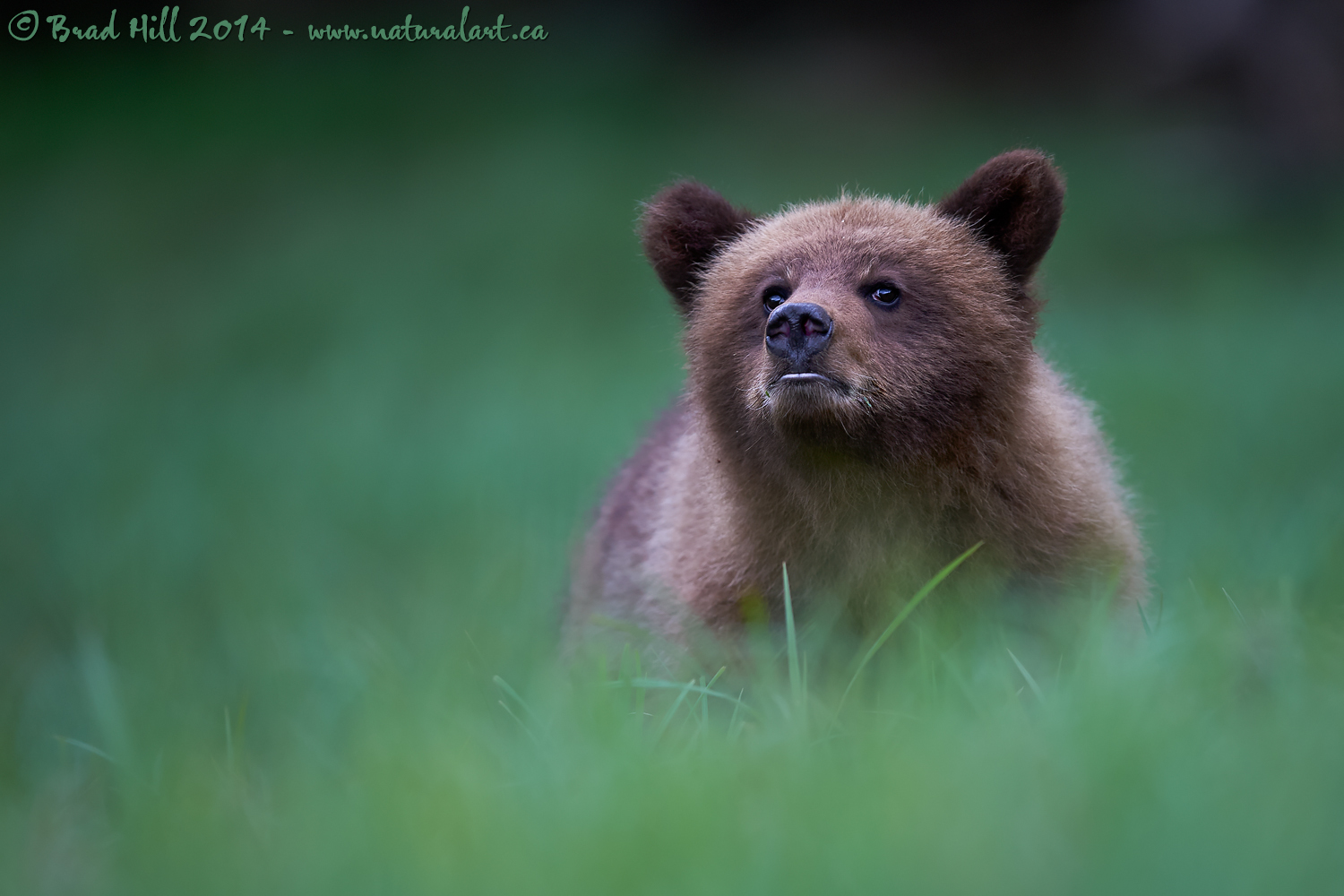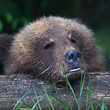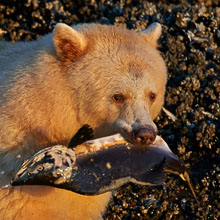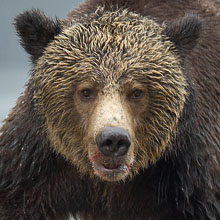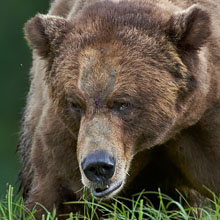Availability: Undetermined - Enquiries?
In the Field
Khutzeymateen 2014 - Year of the Cub! Khutzeymateen Grizzly Sanctuary, northern BC coast, Canada. May 29, 2014.
Each spring I venture into the Khutzeymateen Grizzly Sanctuary and lead photo tours into this magnificent and globally unique "Garden of the Grizzlies". Each and every trip into this magical land is amazing, but the 2014 editions were simply off the charts. Last year we had noticed a paucity of female bears in the area, and several of the recognizable "regulars" were missing. There were a number of possibilities - that they had not survived the winter of 2012/2013; that they had wandered outside the protected region of the sanctuary and met an untimely end at the hands of trophy hunters; or - most optimistically - that they had given birth to cubs and had hesitated to enter the Khutzeymateen estuary and inlet because of the high density of bears found there (fearing for the survival of their cubs). Well, as it turned out, the best case scenario came true, and several females returned to the area in 2014 with yearling (in their 2nd spring) cubs in tow! In fact, cubs so dominated the Khutzeymateen experience this year that it became, quite literally, the "Year of the Cub".
Over the course of the trips we witnessed mothers protectively watching over their cubs as they fed on grass, saw the cubs nursing from ma, and we were even privileged enough to watch a female return to breeding behavior and drive the resident males a little nutty immediately after she weaned her twin 3-year old cubs (this is the first time we've seen cubs remain with their mother into their 4th spring, tho' her time with them this spring was very short). We even watched in amazement as one of the weaned cubs attempted to re-unite with his now "empty-nester" of a mother (suffice to say for now that mom was anything but thrilled with the concept, and made no secret of her feelings...). Add in the "usual" (for the Khutzeymateen) but very dynamic scenes of males competing with one another to claim available females, new-to-the-area bears struggling to find their place in the local pecking order, and bears doing normal day-to-day bear things (like swimming across the estuary right in front of you) and you end up with one of the most compelling experiences a wildlife photographer can imagine.
The shot shown above is of a yearling cub (in its second spring) exploring a grassy knoll while cautiously checking out the strange grey creature (our zodiac boat) that's sitting just offshore. All sensory tools - nose, eyes, ears - are fully engaged and helping the cub determine if we're friend, foe, or simply something that can be safely ignored. I intentionally shot directly through grasses that extended up to the cub's mouth and chose a very wide aperture (f3.2 on my 400mm f2.8 VR) to produce the soft look of the image (and to help make the cub just pop out of the screen). While this "technique" is mostly equipment-driven (it would be impossible to do with a f4 or f5.6 lens) and not particularly unique from a creative perspective, finding the exact right situation where it will effectively work with a wild subject is a fairly big challenge in itself. As this "scene" was developing I saw that my proximity to the grasses in the foreground (very close to me), the distance to the grasses in the background (distant, largely owing to the fact the cub was near the top of rise that fell away behind it) and the angle of the cub coming at me all added up to the exact right situation to go for the soft, shallow DoF shot.
Those that know me and my photographic style and skillset or who closely follow this website are likely aware that I am reasonably proficient at post-processing of digital images. That doesn't mean I take extreme liberties with my shots (I almost never clone anything other than dust specks from an image, don't make extreme enhancement to color saturation, etc.). But I do often put a LOT of work into balancing and tweaking an image's exposure and contrast. But with this image - well...it's straight out of the camera! All I did with this image was export the image from Lightroom to my preferred raw converter (Capture One Pro) and hit the "Process" button. Ya gotta love it when that happens! ;-)
This one is a bit of a treat to view a little larger on a high resolution display (like a Retina Display) - so here's a higher resolution (2400 pixel) image for your perusal:
• Khutzeymateen 2014 - Year of the Cub! Download 2400 pixel image (JPEG: 805 KB)
NOTE 1: This image - in all resolutions - is protected by copyright. I'm fine with personal uses of it (including use as desktop backgrounds or screensavers on your own computer), but unauthorized commercial use of the image is prohibited by law. Thanks in advance for respecting my copyright!
NOTE 2: Like all wildlife images on this website, the subject is fully wild and completely unconstrained. Besides the potential impact of my presence, nothing has been done to intentionally alter or affect the ongoing behavior of the subject and, of course, there has been no use of any form of bait or other form of wildlife attractants (including vocalizations).
NOTE 3: This image was captured during one of my "Grizzlies of the Khutzeymateen" photo tour in the spring of 2014. Each year I offer trips into two different parts of the Great Bear Rainforest as well as one to photograph aquatic mammals and oceanscapes near the northern tip of Vancouver Island. And, in selected years, I also offer photo tours to locations to capture other highly sought-after subjects, such as various boreal owl species and wildlife of Canada's Arctic. Details about these trips can be found on the Photo Tours page of this website.
Behind the Camera
Khutzeymateen 2014 - Year of the Cub! Khutzeymateen Grizzly Sanctuary, northern BC coast, Canada. May 29, 2014.
Digital Capture; Compressed RAW (NEF) 14-bit format; ISO 224.
Nikon D4s paired with Nikkor AF-S 400mm f2.8 VR - hand-held from floating Zodiac. VR on in Normal mode.
1/500s @ f3.2; -0.67 stop compensation from "recommended" matrix-metered exposure setting.
At the Computer
Khutzeymateen 2014 - Year of the Cub! Khutzeymateen Grizzly Sanctuary, northern BC coast, Canada. May 29, 2014.
RAW Conversion to 16-bit TIFF, including first-pass/capture sharpening using Phase One's Capture One Pro.
Image resizing and output sharpening performed using Photoshop CC. No further post-processing performed on the image.
Conservation
Khutzeymateen 2014 - Year of the Cub! Khutzeymateen Grizzly Sanctuary, northern BC coast, Canada. May 29, 2014.
Ten percent of the revenue generated by this image will be donated to Raincoast*.
Species Status in Canada**: Special Concern (May 2002).
While Grizzly Bears (Ursus arctos) are not technically listed as "Endangered" in Canada, they have been extirpated from most of their historical range. Grizzly Bears are far more sensitive to intrusion/disturbance in their habitat than are Black Bears and are being increasingly forced into marginal habitat by human encroachment. The Great Bear Rainforest along the central and northern coast of British Columbia is one of the last strongholds of the Grizzly Bear in Canada, and even this population is coming under increasing pressure.
On December 18, 2017 the government of British Columbia banned grizzly hunting across the entire province. This major conservation victory came after decades of tireless work by many dedicated conservationists and ecologists and, most importantly, it reflects the opinion of the vast majority of British Columbians. And, it means that AT LEAST while the current government remains in power grizzlies are finally "safe" in British Columbia.
Now that we've at least temporarily won the battle to save grizzlies in BC, it's time to re-focus our efforts toward protecting ALL of BC's carnivores, including Gray Wolves, Black Bears, Cougars, Wolverines, and more! Simply put, there are no ecological, economic, or ethical arguments supporting the trophy hunting of carnivores.
In a great first step towards ending the hunting of carnivores throughout BC the Raincoast Conservation Foundation has developed a program designed to protect ALL carnivores within the Great Bear Rainforest. Details about this program can be found on this page on Raincoast's website. Check it out and, better yet, make a donation to help Raincoast purchase the remaining commercial hunting tenures in the Great Bear!
*The Raincoast Conservation Society (and Foundation) is an effective and efficient organization that has been fighting for protection of this unique habitat. If you are looking for a meaningful way to contribute to the conservation of this amazing ecosystem, Raincoast will provide maximal "bang" for your conservation dollars.
**as determined by COSEWIC: The Committee on the Status of Endangered Wildlife in Canada












